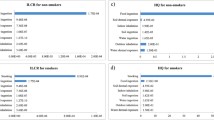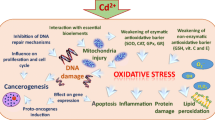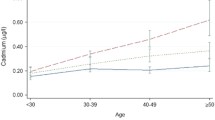Abstract
Cadmium is ubiquitous in the environment and in food and accumulates in the body, affecting kidney, lung, and bone. The aggregate exposure to cadmium was probabilistically estimated through two major routes: ingestion of food and water and inhalation of ambient air/tobacco smoke, followed by health risk assessment, with focus on the cardinal systemic effect of cadmium, nephrotoxicity. The magnitude of the aggregate intake was estimated with the Monte Carlo method, using actual occurrence and consumption data. As absorption rates of the individual exposure routes determine the internal exposure, alternative exposure scenarios considered different relationships between the absorption capacities for the individual exposure routes, according to published experimental and modelling data. Emphasis was placed on the exposure of women, a vulnerable population. Intake and internal exposure levels were compared with health-based guidance values and with a cut-off level for renal effects, respectively. Proportions of individuals with intakes exceeding these values, as well as contributions of the individual exposure routes to the aggregate exposure were calculated. The contribution of inhalation to the aggregate intake of non-smokers is negligible, whilst it is prominent for smokers. Risks are high for smokers, especially those consuming non-filtered cigarettes, and are maximized for women. Internal exposures of smokers exceed the cut-off value for irreversible renal effects up to 2.2-fold. The percentage of smokers with exposures exceeding the health-based guidance values is alarming, reaching 77% for women. Occurrence data gaps, simulation of the smoking pattern, and lack of information about passive smoking exposures are main sources of uncertainty.



Similar content being viewed by others
Data Availability
Confidential and proprietary data.
Code Availability
Not applicable.
Abbreviations
- AGES:
-
Austrian Agency for Health and Food Safety
- ATSDR:
-
Agency for Toxic Substances and Disease Registry
- B2M:
-
Beta-2-microglobulin
- b.w.:
-
Body weight
- EFSA:
-
European Food Safety Authority
- FAO:
-
Food and Agriculture Organization of the United Nations
- GF-AAS:
-
Atomic Absorption-Graphite Furnace technique
- IARC:
-
International Agency for Research on Cancer
- ICP-MS:
-
Inductively Coupled Plasma-Mass Spectrometry
- JECFA:
-
Joint Expert Committee on Food Additives
- JRC:
-
Joint Research Centre of the European Commission
- LOQ:
-
Limit of Quantification
- MCRA:
-
Monte Carlo Risk Assessment
- P95:
-
95th percentile
- PM:
-
Particulate Matter
- PM10/ PM2.5 :
-
Particulate Matter with a diameter of 10/2.5 μm or less
- PTWI:
-
Provisional Tolerable Weekly Intake
- RIVM:
-
The Dutch National Institute for Public Health and the Environment
- TWI:
-
Tolerable Weekly Intake
- WHO:
-
World Health Organization
References
Austrian Federal Environment Agency, Zethner G, Goodchild R (2001) A Risk Assessment for Cadmium in Austria based on the Recommendations of ERM. Final Report. Vienna, Austria.
AGES, Austrian Agency for Health and Food Safety, Vlachou C, Hofstädter D (2019) Joint venture on the further development of chemical exposure assessment by use of probabilistic modelling. EFSA Journal 17(S2): e170905. https://doi.org/10.2903/j.efsa.2019.e170905
Åkesson A, Berglund M, Schutz A, Bjellerup P, Bremme K, Vahter M (2002) Cadmium exposure in pregnancy and lactation in relation to iron status. Am J Public Health 92(2):284–287. https://doi.org/10.2105/ajph.92.2.284
Åkesson A, Bjellerup P, Lundh T, Lidfeldt J, Nerbrand C, Samsioe G, Skerfving S, Vahter M (2006) Cadmium-induced effects on bone in a population-based study of women. Environ Health Perspect 114:830–834. https://doi.org/10.1289/ehp.8763
Amzal B, Julin B, Vahter M, Wolk A, Johansson G, Åkesson A (2009) Population toxicokinetic modeling of cadmium for health risk assessment. Environ Health Perspect 117(8):1293–1301. https://doi.org/10.1289/ehp.0800317
ANSES, French Agency for Food, Environmental and Occupational Health & Safety (2014) Collective expert appraisal: Summary and conclusions regarding the "expert appraisal for recommending occupational exposure limits for chemical agents". Assessment of health effects and methods for the measurement of exposure levels in workplace atmospheres for cadmium and its compounds. https://www.anses.fr/en/system/files/VLEP2007SA0425RaEN.pdf. Accessed 02 October 2021.
Aoshima K, Fan J, Cai Y, Katoh T, Teranishi H, Kasuya M (2003) Assessment of bone metabolism in cadmium-induced renal tubular dysfunction by measurements of biochemical markers. Toxicol Lett 136(3):183–192. https://doi.org/10.1016/S0378-4274(02)00356-9
ATSDR, Agency for Toxic Substances and Disease Registry (2012) Toxicological profile for Cadmium. U.S. Department of Health and Human Services, Public Health Service, p. 261–305. https://www.atsdr.cdc.gov/toxprofiles/tp5.pdf. Accessed 21 October 2020.
Baldantoni D, Morra L, Zaccardelli M, Alfani A (2016) Cadmium accumulation in leaves of leafy vegetables. Ecotoxicol Environ Saf 123:89–94. https://doi.org/10.1016/j.ecoenv.2015.05.019
Becker K, Schulz C, Kaus S, Seiwert M, Seifert B (2003) German Environmental Survey 1998 (GerES III): Environmental pollutants in the urine of the German population. Int J Hyg Environ Health 206(1):15–24. https://doi.org/10.1078/1438-4639-00188
Berglund M, Akesson A, Nermell B, Vahter M (1994) Intestinal-absorption of dietary cadmium in women depends on body iron stores and fiber intake. Environ Health Perspect 102(12):1058–1066. https://doi.org/10.1016/0300-483X(81)90111-6
de Boer WJ, Goedhart PW, Hart A, Kennedy MC, Kruisselbrink J, Owen H, Roelofs W, van der Voet H (2019) MCRA 8.3 a Web-based Program for Monte Carlo Risk Assessment. Reference Manual. February 2019. WUR/Biometris, Wageningen, Netherlands. Food and Environmental Research Agency (FERA), York, U.K. National Institute for Public Health and the Environment (RIVM), Bilthoven, Netherlands.
Cetintepe SP, Iritas SB, Gunduzoz M, Alaguney ME, Wilson D, Bal C, Yilmaz OH, Tutkun L, Park E-K (2019) Relation between lung dysfunction and blood cadmium and lead levels among welders. Expo Health 11:13–19. https://doi.org/10.1007/s12403-017-0262-x
Charania NA, Tsuji LJS, Martin ID, Liberda EN, Coté S, Ayotte P, Dewailly E, Nieboer E (2014) An examination of traditional foods and cigarette smoking as cadmium sources among the nine First Nations of Eeyou Istchee, Northern Quebec, Canada. Environ Sci Process Impacts 16(6):1422–1433. https://doi.org/10.1039/c4em00064a
Choudhury H, Harvey T, Thayer WC, Lockwood TF, Stiteler WM, Goodrum PE, Hassett JM, Diamond GL (2001) Urinary cadmium elimination as a biomarker of exposure for evaluating a cadmium dietary exposure-biokinetics model. J Toxicol Environ Health Part A 63:321–350. https://doi.org/10.1080/15287390152103643
Council Directive 98/83/EC of 3 November 1998 on the quality of water intended for human consumption. ELI: http://data.europa.eu/eli/dir/1998/83/oj.
EFSA, European Food Safety Authority (2012a) EFSA Panel on Contaminants in the Food Chain (CONTAM); Scientific Opinion on tolerable weekly intake for cadmium. EFSA Journal 2011;9(2):1975. doi:10.2903/ j.efsa.2011.1975.
EFSA, European Food Safety Authority (2012b) EFSA Panel on Plant Protection Products and their Residues (PPR); Guidance on the Use of Probabilistic Methodology for Modelling Dietary Exposure to Pesticide Residues. EFSA Journal 2012;10(10):2839. https://doi.org/10.2903/j.efsa.2012.2839.
EFSA, European Food Safety Authority (2009a) Scientific opinion of the panel on contaminants in the food chain on a request from the European Commission on cadmium in food. The EFSA Journal 2009(980):1–139
EFSA, European Food Safety Authority (2009b) General principles for the collection of national food consumption data in the view of a pan-European dietary survey. EFSA J 7(12):1435. https://doi.org/10.2903/j.efsa.2009.1435
EFSA, European Food Safety Authority (2010) Management of left-censored data in dietary exposure assessment of chemical substances. EFSA Journal 2010;. doi:https://doi.org/10.2903/j.efsa.2010.1557.
EFSA, European Food Safety Authority (2011) Report on the development of a food classification and description system for exposure assessment and guidance on its implementation and use. EFSA Journal 2011;9(12):2489.
Ferraro PM, Costanzi S, Naticchia A, Sturniolo A (2010) Gambaro G (2010) Low level exposure to cadmium increases the risk of chronic kidney disease: analysis of the NHANES 1999–2006. BMC Public Health 10:304. https://doi.org/10.1186/1471-2458-10-304
Finley B, Paustenbach D (1994) The benefits of probabilistic exposure assessment: three case studies involving contaminated air, water, and soil. Risk Anal 14(1):53–73. https://doi.org/10.1111/j.1539-6924.1994.tb00028.x
Flanagan PR, McLellan JS, Haist J, Cherian G, Chamberlain MJ, Valberg LS (1978) Increased dietary cadmium absorption in mice and human subjects with iron deficiency. Gastroenterology 7:841–846. https://doi.org/10.1016/0016-5085(78)90138-5
Gupta CR (2011) Reproductive and Developmental Toxicology, 1st edn. Academic Press U, S.A
Huff J, Lunn RM, Waalkes MP, Tomatis L, Infante PF (2007) Cadmium-induced cancers in animals and in humans. Int J Occup Environ Health 13(2):202–212. https://doi.org/10.1179/oeh.2007.13.2.202
IARC, International Agency for Research on Cancer (2012) Monograph: Cadmium and Cadmium Compounds. https://monographs.iarc.fr/wp-content/uploads/2018/06/mono100C-8.pdf. Accessed 21 October 2020.
Järup L, Hellstrom L, Alfven T, Carlsson MD, Grubb A, Persson B, Pettersson C, Spang G, Schutz A, Elinder C (2000) Low level exposure to cadmium and early kidney damage: the OSCAR study. Occup Environ Med 57:668–672. https://doi.org/10.1136/oem.57.10.668
JECFA, Joint FAO/WHO Expert Committee on Food Additives, Food and Agriculture Organization of the United Nations & World Health Organization (1988) Evaluation of certain food additives and contaminants: thirty-third report of the Joint FAO/WHO Expert Committee on Food Additives [meeting held in Geneva from 21 to 30 March 1988]. World Health Organization. https://apps.who.int/iris/handle/10665/39252. Accessed 14 November 2020.
Johnson MD, Kenney N, Stoica A, Hilakivi-Clarke L, Singh B, Chepko G, Clarke R, Sholler PF, Lirio AA, Foss C, Reiter R, Trock B, Paik S, Martin MB (2003) Cadmium mimics the in vivo effects of estrogen in the uterus and mammary gland. Nat Med 9(8):1081–1084. https://doi.org/10.1038/nm902
JRC, Joint Research Centre of the European Commission (2008) Cadmium Metal and Cadmium Oxide - Summary Risk Assessment Report, European Communities. https://publications.jrc.ec.europa.eu/repository/bitstream/JRC46383/cdmetal_cdoxidesum302.pdf. Accessed 4 July 2020.
Julin B, Vahter M, Amzal B, Wolk A, Berglund M, Åkesson A (2011) Relation between dietary cadmium intake and biomarkers of cadmium exposure in premenopausal women accounting for body iron stores. Environ Health 10:105. https://doi.org/10.1186/1476-069X-10-105
Kippler M, Ekström EC, Lönnerdal B, Goessler W, Akesson A, El Arifeen S, Persson LA, Vahter M (2007) Influence of iron and zinc status on cadmium accumulation in Bangladeshi women. Toxicol Appl Pharmacol 222(2):221–226. https://doi.org/10.1016/j.taap.2007.04.009
Kjellström T (1992) Mechanism and epidemiology of bone effects of cadmium. IARC Sci Publ 118:301–310
Kobayashi E, Suwazono Y, Dochi M, Honda R, Nishijo M, Kido T, Nakagawa H (2008) Estimation of benchmark doses as threshold levels of urinary cadmium, based on excretion of beta2-microglobulin in cadmium-polluted and non-polluted regions in Japan. Toxicol Lett 179(2):108–112. https://doi.org/10.1016/j.toxlet.2008.04.013
Komarnicki GJK (2005) Lead and cadmium in indoor air and the urban environment. Environ Pollut 136(1):47–61. https://doi.org/10.1016/j.envpol.2004.12.006
Kroes R, Müller D, Lambe J, Löwik MRH, van Klaveren J, Kleiner J, Massey R, Mayer S, Urieta I, Verger P, Visconti A (2002) Assessment of intake from the diet. Food Chem Toxicol 40:327–385. https://doi.org/10.1016/s0278-6915(01)00113-2
McLellan JS, Flanagan PR, Chamberlain MJ, Valberg LS (1978) Measurement of dietary cadmium absorption in humans. J Toxicol Environ Health 4:131–138. https://doi.org/10.1080/15287397809529650
Mondal D, Polya DA (2008) Rice is a major exposure route for arsenic in Chakdaha block, Nadia district, West Bengal, India: A probabilistic risk assessment. Appl Geochemistry 23(2008):2987–2998. https://doi.org/10.1016/j.apgeochem.2008.06.025
Neuberger M (2019) Tobacco control: prevention and cessation in Europe. Mag Eur Med Oncol. https://doi.org/10.1007/s12254-019-0485-6
Newton D, Johnson P, Lally AE, Pentreath RJ, Swift DJ (1984) The uptake by man of cadmium ingested in crab meat. Human Toxicol 3(1):23–28. https://doi.org/10.1177/0960327184003001031
Noor N, Zong G, Seely EW, Weisskopf M, James-Todd T (2018) Urinary cadmium concentrations and metabolic syndrome in U.S. adults: The National Health and Nutrition Examination Survey 2001–2014. Environ Int 121(Pt1):349–356. https://doi.org/10.1016/j.envint.2018.08.029
Nordberg GF, Bernard A, Diamond GL, Duffus JH, Illing P, Nordberg M, Bergdahl IA, Jin T, Skerfving S (2018) Risk assessment of effects of cadmium on human health (IUPAC Technical Report). Pure and Appl Chem 90(4):755–808. https://doi.org/10.1515/pac-2016-0910
Pääkkö P, Kokkonen P, Anttila S, Kalliomäki P-L (1989) Cadmium and chromium as markers of smoking in human lung tissue. Environ Res 49(2):197–207. https://doi.org/10.1016/S0013-9351(89)80065-9
Pappas RS (2011) Toxic elements in tobacco and in cigarette smoke: inflammation and sensitization. Metallomics 3(11):1181–1198. https://doi.org/10.1039/c1mt00066g
Peraza MA, Ayala-Fierro F, Barber DS, Casarez E, Rael LT (1998) Effects of micronutrients on metal toxicity. Environ Health Perspect 106(Suppl I):203–207. https://doi.org/10.1289/ehp.98106s1203
Piadé J-J, Jaccard G, Dolka C, Belushkin M, Wajrock S (2015) Differences in cadmium transfer from tobacco to cigarette smoke, compared to arsenic or lead. Toxicol Rep 2:12–26. https://doi.org/10.1016/j.toxrep.2014.11.005
RIVM, Dutch National Institute for Public Health and the Environment, Bos PMJ, Hernández LG, Mennes WC, Kienhuis AS, Talhout R (2012) Risk assessment of tobacco additives and smoke components. RIVM Letter Report 340031001/2012. https://www.rivm.nl/bibliotheek/rapporten/340031001.pdf. Accessed 16 November 2020.
Rojas-Lima E, Rothenberg SJ, Gamboa-Loira B, Mérida-Ortega Á, Cebrián ME López-Carrillo L (2021) Cadmium, selenium and breast cancer risk by molecular subtype among women from Northern Mexico. Expo Health. https://doi.org/10.1007/s12403-021-00393-w
Rust P, Hasenegger V, König J (2017) Österreichischer Ernährungsbericht (Austrian Nutrition Report) 2017. University of Vienna, Vienna, Austria
Shi Z, Carey M, Davidson E, Meharg C (2020) Meharg AA Avoiding rice-based cadmium and inorganic arsenic in infant diets through selection of products low in concentration of these contaminants. Expo Health. https://doi.org/10.1007/s12403-020-00376-3
Austrian Federal Environment Agency, Spangl W, Nagl C (2019) Annual Report of Air Quality Measurements in Austria 2018. Report REP-0675. Vienna 2019. https://www.umweltbundesamt.at/fileadmin/site/publikationen/REP0675.pdf. Accessed 12 November 2020.
Spiegel H, Sager M, Oberforster M, Mechtler K, Stüger HP, Baumgarten A (2009) Nutritionally relevant elements in staple foods: influence of arable site versus choice of variety. Environ Geochem Health 31:549–560. https://doi.org/10.1007/s10653-009-9254-5
Stahr S, Tc C, Bauer MA, Runnells GA, Rogers LJ, Do HV, Kadlubar SA, Su LJ (2021) Low-level environmental heavy metals are associated with obesity among postmenopausal women in a southern state. Expo Health. https://doi.org/10.1007/s12403-020-00381-6
Tellez-Plaza M, Jones MR, Dominguez-Lucas A, Guallar E, Navas-Acien A (2013) Cadmium exposure and clinical cardiovascular disease: a systematic review. Curr Atheroscler Rep 15(10):356. https://doi.org/10.1007/s11883-013-0356-2
UNEP, United Nations Environment Programme (2010) Final review of scientific information on cadmium. https://wedocs.unep.org/xmlui/bitstream/handle/20.500.11822/27636/Cadmium_Review.pdf?sequence=1&isAllowed=y. Accessed 3 April 3 2021.
van der Voet H, de Boer WJ, Kruisselbrink JW, Goedhart PW, van der Heijden GWAM, Kennedy MC, Boon PE, van Klaveren JD (2015) The MCRA model for probabilistic single-compound and cumulative risk assessment of pesticides. Food Chem Toxicol 79:5–12. https://doi.org/10.1016/j.fct.2014.10.014
Vanderpool RA, Reeves PG (2001) Cadmium absorption in women fed processed edible sunflower kernels labeled with a stable isotope of cadmium, 113Cd. Environ Res 87(2):69–80. https://doi.org/10.1006/enrs.2001.4288
Vejdovszky K, Mihats D, Griesbacher A, Wolf J, Steinwider J, Lueckl J, Jank B, Kopacka I, Rauscher-Gabernig E (2019) Modified Reference Point Index (mRPI) and a decision tree for deriving uncertainty factors: A practical approach to cumulative risk assessment of food contaminant mixtures. Food Chem Toxicol 134:110812. https://doi.org/10.1016/j.fct.2019.110812
Vlachou C, Hofstädter D, Rauscher-Gabernig E, Griesbacher A, Fuchs K, König J (2020a) Risk assessment of nitrites for the Austrian adult population with probabilistic modelling of the dietary exposure. Food Chem Toxicol 143:111480. https://doi.org/10.1016/j.fct.2020.111480
Vlachou C, Hofstädter D, Rauscher-Gabernig E, Griesbacher A, Fuchs K, König J (2020b) Probabilistic risk assessment of nitrates for Austrian adults and estimation of the magnitude of their conversion into nitrites. Food Chem Toxicol 145:111719. https://doi.org/10.1016/j.fct.2020.111719
Vlachou C, Griesbacher A, Wolf J, Mihats D, Steinwider J, Fuchs K, Hofstädter D (2021a) Probabilistic modelling techniques in dietary exposure assessment: Application on the risk assessment of cadmium for Austrian adults. Food Addit Contam Part A Chem Anal Control Expo Risk Assess 38(8):1301–1315. https://doi.org/10.1080/19440049.2021.1921282
Vlachou C, Vejdovszky K, Wolf J, Steinwider J, Fuchs K, Hofstädter D (2021b) Toxicological approaches for the quantitative inhalation risk assessment of toxic metals from tobacco smoke: application on the deterministic and probabilistic inhalation risk assessment of cadmium for austrian smokers. Inhal Toxicol 33(4):128–142. https://doi.org/10.1080/08958378.2021.1912859
WHO, World Health Organization (2000) Air Quality Guidelines for Europe. World Health Organization. Regional Office for Europe, Copenhagen. WHO Regional Publications, European Series, No. 91. 2nd Edition. https://www.euro.who.int/__data/assets/pdf_file/0005/74732/E71922.pdf. Accessed 16 November 2020.
WHO, World Health Organization (2010a) WHO human health risk assessment toolkit: Chemical hazards (IPCS harmonization project document; no. 8). https://apps.who.int/iris/bitstream/handle/10665/44458/9789241548076_eng.pdf;jsessionid=06F72D6403A31B82B28A6AF5AEB03907?sequence=1. Accessed 25 June 2020.
WHO, World Health Organization (2010b) Exposure to Cadmium: A Major Public Health Concern (2019 Revision). https://apps.who.int/iris/bitstream/handle/10665/329480/WHO-CED-PHE-EPE-19.4.3-eng.pdf. Accessed 8 December 2019.
Acknowledgements
The authors wish to thank the European Food Safety Authority (EFSA), as this work was part of the risk assessment on cadmium, implemented by the Austrian Agency for Health and Food Safety (AGES) within EFSA’s EU-FORA (EU Food Risk Assessment) Fellowship Programme. The first author was hosted as a fellow of the 2018–2019 cohort at the Department of Risk Assessment of the Data, Statistics and Risk Assessment Division of AGES in Vienna. Food and drinking water samples were collected by the Austrian Food Control Authority with the support of the Austrian Federal Ministry for Social Affairs, Health, Care and Consumer Protection. Consumption data were collected by the University of Vienna with the support of the Austrian Federal Ministry for Social Affairs, Health, Care and Consumer Protection and EFSA. Tobacco products samples were collected within the framework of the Official Control and Inspections in Austria. Chemical analyses were conducted in the laboratories of the AGES Institute for Food Safety in Vienna.
Funding
Not applicable.
Author information
Authors and Affiliations
Contributions
Conceptualization: [Christina Vlachou, Katharina Vejdovszky]; Methodology: [Christina Vlachou]; Formal analysis and investigation: [Christina Vlachou]; Writing—original draft preparation: [Christina Vlachou]; Writing—review and editing: [Katharina Vejdovszky, Antonia Griesbacher, Johann Steinwider, Daniela Hofstädter, Klemens Fuchs]; Resources: [Klemens Fuchs]; Supervision: [Daniela Hofstädter, Klemens Fuchs].
Corresponding author
Ethics declarations
Conflict of interest
The authors have no conflicts of interest to declare that are relevant to the content of this article.
Additional information
Publisher's Note
Springer Nature remains neutral with regard to jurisdictional claims in published maps and institutional affiliations.
Rights and permissions
About this article
Cite this article
Vlachou, C., Vejdovszky, K., Griesbacher, A. et al. Probabilistic Estimation of the Aggregate Dietary and Inhalation Exposure of Austrian Adults to Cadmium and Health Risk Assessment. Expo Health 14, 843–856 (2022). https://doi.org/10.1007/s12403-021-00459-9
Received:
Revised:
Accepted:
Published:
Issue Date:
DOI: https://doi.org/10.1007/s12403-021-00459-9




